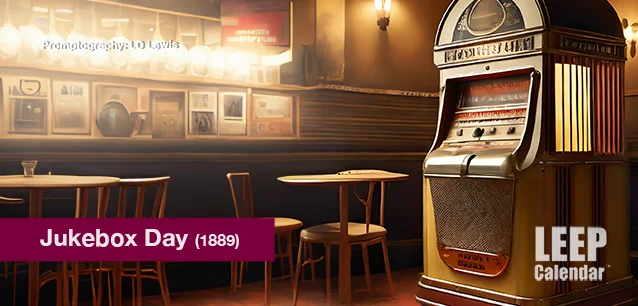 AD
AD
Today is: November 05
Scroll to explore events active on this date.
LEEP INK FEATURES

August is Appropos
A toddler playing in the fountain at a park in Santa Fe, New Mexico—Photo LD Lewis. In August, we live through the Dog Days of Summer. It's hot and often humid, and those ...

September is Sassy
Can you hear that sigh of relief from parents worldwide? Yes! September marks the return of students to school, a global phenomenon. Preparations for the ACT and SATs begin earnestly for ...

OOH LA LA, October
October is the busiest month for events, with 5% more happening than in May, the second most eventful month. Sailing enthusiasts will be glued to the finals of this year's Am...
About Jukebox Day
Music , Entertainment
United States
Ends: Nov 22, 2023
DESCRIPTION:
Jukebox Day celebrates the November 23, 1889, release of the first paid phonograph machine. The date accommodates the Thanksgiving holiday in the United States each year.
The jukebox, an iconic symbol of American pop culture, has a rich history that spans over a century, mirroring the evolution of music and technology. Its journey from a simple music-playing device to a cultural phenomenon reflects the changing landscape of how people have enjoyed and shared music over the years.
The precursor to the modern jukebox appeared in the late 19th century with the invention of the phonograph by Thomas Edison in 1877. However, in the early 20th century, these music players began to be widely used in public spaces. The first coin-operated phonograph was introduced by the Pacific Phonograph Co. in 1889, debuting in San Francisco. These early machines were simple; a patron would insert a coin and listen to a music selection using earphones.
The term "jukebox" came into use in the 1930s, derived from the African-American vernacular term "juke," meaning disorderly, rowdy, or wicked. Jukeboxes gained immense popularity during the 1930s and 1940s, particularly after the invention of the amplified electric jukebox by the Automated Musical Instrument Company (AMI) in 1927. This innovation allowed music to be played loudly enough to be heard throughout a bar or restaurant, making the jukebox a communal music experience.
The golden age of the jukebox was in the 1940s and 1950s, coinciding with the heyday of rhythm and blues, jazz, and the early years of rock and roll. Jukeboxes were not just music-playing machines; they became stylish fixtures in diners, soda shops, and dance halls, often featuring flashy lights and Art Deco designs. They played a significant role in the diffusion of popular music, helping new artists and genres gain exposure.
The 1960s and 1970s saw a decline in the popularity of jukeboxes as portable radios and, later, cassette players changed how people listened to music. However, jukeboxes continued to evolve technologically, with some transitioning to play 45 rpm singles instead of the older 78 rpm records.
In recent decades, the jukebox has experienced a resurgence in nostalgia-driven venues and as collectibles. Digital and internet-connected jukeboxes have also emerged, allowing users to select from various songs. However, these modern iterations need more charm and physicality of the vinyl and CD jukeboxes of the past.
VIDEOS
SUPPORTING DOCUMENTS
Currently, this event does not have supporting documents.
ADDITIONAL IMAGES
Currently, this event does not have supporting images.
Where would you like to go now?
 AD
AD


/footer-logo.svg)
